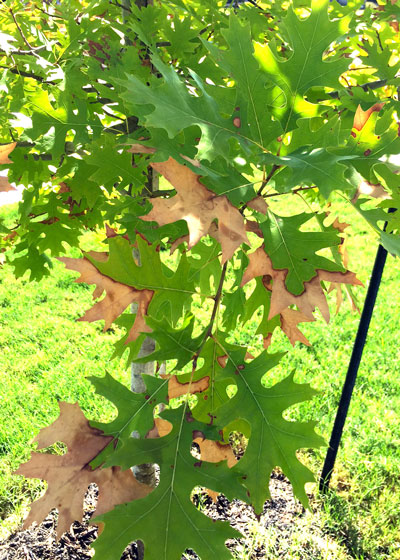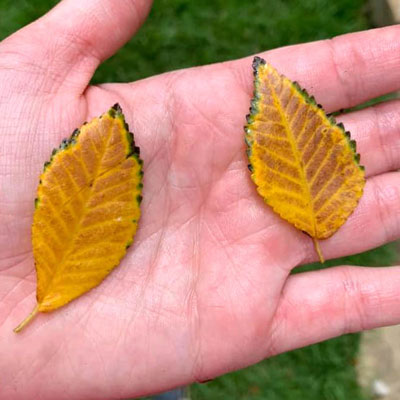Question of the Week – Number 3: July 29, 2021

“Why are the leaves on my red oak tree turning brown around their edges?”
When I am asked to explain marginal leaf scorch, sooner or later I compare it to the human circulatory system. This time, I’ll begin with it.
Think about what happens to the human body with frostbite. Damage is done to the points farthest from the heart: fingertips, toes, ears and the nose.
The tips and edges of leaves are comparable in our plants. They are the points farthest from the roots, so they are the first places to dry out and the last places to get water. If the plant is in any kind of water stress, it will exhibit at the margins of the leaves first.
So that means that this red oak is suffering from moisture stress. Which sounds like that’s the answer.
Job done. Right?
Nope. The real work isn’t finished. There are many things that could lead to that. Let me list them.

Possible causes of moisture stress…
If you think about it for just a few moments you’ll realize how lengthy this list could be.
• Plant simply got too dry one or more times. This often happens in first couple of years after planting because people rely on sprinkler irrigation rather than deep soakings via hand watering.
• Roots were lost in transplanting. When roots are cut by a nursery spade, important “feeder” roots are left behind.
• High temperatures beyond which a plant species is adapted – using a plant from a cooler climate in hot Texas conditions.
• Choosing a plant that has been growing in a protected location and moving it into a hot, sunny site without proper conditioning. You bought it in a nursery shade house and planted it out into the sun.
• Hot, drying winds channeling across the plant’s foliage. Maybe it’s growing beside the air conditioner, or perhaps you had it in the back of the pickup on the way home from the nursery.
• Trunk damage due to line trimmer, mower wheel, rodents, etc. No need to say more.
• Too much fertilizer was applied. It creates an excess of mineral salts that draws water out of the plants’ roots.
• Or, in the case of thin-barked young trees such as red oaks, water oaks, red maples and others, planting young nursery-grown trees into full sun where they suddenly have no shading from the hot western sun in the afternoons. That’s what may be going on in this photo, since this tree appears to be only a year or two in the ground. Sunscald causes red oak bark to split and then peel. Then water and manufactured sugars aren’t conducted up and down the tree’s tissues properly and the tree begins to exhibit stress symptoms like this. Sadly, I see this happen many times every year. It’s usually three or four years after the tree has been planted.
Just remember that anytime you see marginal or tip burn to the leaves of any plant that you’re growing, moisture stress is involved. Your task at that point is to set your mind at figuring out what the cause of that stress might be.
